A Chronological Tour
The aim of the 2007 Diggings tour of Greece and Italy was to trace civilisation from its earliest appearance in Europe to its collapse under the wave of babarian invasions that put an end to the Roman empire. Taking everything in chronological order on the ground would have been too time consuming and expensive, but doing it here in print is another matter.
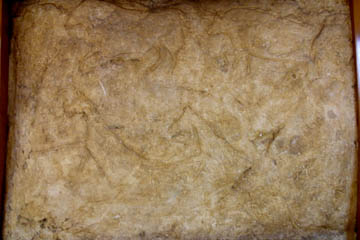
Probably the earliest indication of civilisation that we saw was the prehistoric rock art preserved in the National Archaeological Museum in Palermo, Sicily. These pictures, scratched into a rock face with deft, sure strokes, showed a variety of human and animal figures in a way that was by no means primitive. The animals in particular were lifelike and full of life and action.
Given the way in which our art has gone from the glories of Leonardo da Vinci and Michaelangelo to the abstract daubings of a succession of highly-priced artistic pretenders, I suppose we should not be surprised to find that the next art we saw - next in terms of chronology - were the extremely abstract human figures of the Cycladic Idols which fill one gallery of the Athens Archaeological Museum.
Next we turned to the first flowerings of what we would call "civilisation" in the wonderful frescoes from Thera (modern Santorini) in an upstairs room of the same museum. Jars of carbonised grain and other organic materials that were burned and buried in the massive eruption of the island volcano were also on display.
Then we found the wonderful gold masks and other jewellery found by Schliemann in the royal graves at Mycenae which are almost the first thing the visitor to the museum encounters (apart from the discourteous and obstructive museum attendants). It was most interesting a few days later to visit Mycenae itself and marvel at the wonderful Lion Gate, where two lions are carved in relief on a massive block of stone that was somehow hoisted into position high above the huge stones that make up the lintel and doorposts of the gateway.
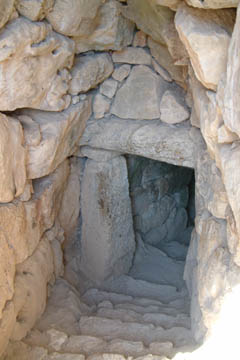
Eight of the group had had the foresight to pack torches and they carried these up onto the citadel of Mycenae where there is further evidence of the sophistication of Mycenaen architecture in the form of a stairway that descends in a man-made tunnel to a cistern 18m below ground level. The cistern was fed by a hidden aqueduct that channelled water into it when rain fell - and the water entrance in the roof of the cistern was filled with a carefully graded mixture of stones and gravel that served to filter the water before it reached the cistern.
Several of the sites we visited, such as Olympia and Delphi, spanned the rise and fall of the Greek city states. Olympia, home of the Olympic Games, gave Greece the most reliable chronological system of the ancient world. Instead of relying on the regnal years of a king - and kings had an untidy habit of not dying on the anniversary of their coronation or of ruling at the same time as their sons or rival rulers elsewhere in the kingdom - the Greeks dated everything in terms of the Games, which were held every four years. A date such as "the second year of the forty-eighth Olympiad" is as precise as our system of AD and BC.
We were horrified at how close the recent fires had come to the site of Olympia, and some members of the group almost missed the bus by staying to watch the felling of a burned tree that stood only a few feet away from the museum. Two members of the group made their visit memorable by actually running an Olympic race - charging down the length of the stadium in the heat of the day. I timed them at 29 and 30 seconds respectively.
Delphi, whose site is half-way up the steep slopes of Mt Parnassus, was one of the more interesting places we visited and I was surprised that everyone, even the oldest and most unfit (like me!) not only followed our guide round all the lower ruins, but actually carried on when the guide turned back and climbed to the stadium right at the top. Mind you, no one had the energy to run races when they got there!
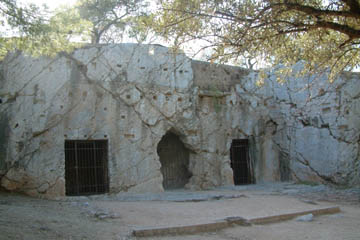
The next place in point of time - though not in terms of our visit, of course - was Athens, where we inspected the archtectural marvels of the Acropolis and Parthenon, roamed the intellectual marvels of the Stoa and Agora where Plato and Artistotle once walked with their students, shook our heads with sorrow at the bare rooms of the Prison of Socrates and risked our lives in the hustle and bustle of modern Athenian traffic.
We also visited the memorial of the city's military greatness and paid our respects at the great mound raised over the fallen Greek warriors on the field of Marathon. We were unexpectedly delighted when we visited the nearby museum to be allowed to visit the somewhat smaller Mound of the Plateans. This has been closed for many years, so it was a thrill to have one of the museum staff accompany us down to the mound and unlock the door. We trooped inside the mound and found there the excavated graves of eleven men from Platea who had died fighting alongside their Athenian allies. We came from there in a somewhat subdued mood, feeling that we had viewed heroes, to whose sacrifice we, nearly two and a half thousand years later, owed most of our civilisation.
Almost as important in the story of Western Civilisation was our visit to northern Greece. The itinerary had called for us to visit Pella, the birthplace of Alexander the Great, but when we discovered that our guide in the north was an archaeologist who had worked at Vergina, we changed our plans and went with him to the huge burial mound that covered the tomb of Phillip, Alexander's father.
I had read about this discovery, of course, and seen pictures of the mound, but until you actually stand inside and find that a whole museum fits in it comfortably that you appreciate just how massive it is. I was astonished to walk round and find that the mound covered several tombs, not just that of Phillip, and among the larger tombs was one that the signboards identified as the grave of the son of Alexander and Roxanne, who had been murdered along with his mother by Cassander, the general who had received Greece as his share of Alexander's empire.
It was sobering that the previous day we had visited the site of their murder, the city of Amphipolis, which at one time was a quite important port. Roxanne and her son had landed there to make their claim for Alexander's crown, and had been seized by Cassander's agents and murdered, some say by poison. A magnificent tomb is poor compensation, to my thinking.
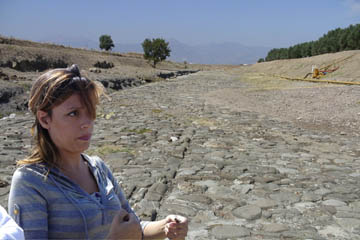
To follow chronology and ignore the order of our trip, we then toured the scenes of Greek expansion and colonisation, the cities of Magna Graecia, the name given to the Greek settlements in southern Italy and Sicily. Down in the "instep" of Italy we were taken round the ruins of Sybaris by a charming young lady, one of four sisters who own the site and have formed a cooperative to excavate it. She was able to point out the various features of the surviving remains, but it was left to me, as we travelled down the "toe" of Italy to amuse the group with the tale of a Sybarite who tossed and turned all night, unable to get comfortable in his luxuriously soft bed. When morning came he discovered a single crumpled rose petal from his garland, which had kept him awake all night. The story, needless to say, was told in contemptuous tones by other Greeks and not by the Sybarites themselves. Envy rather than factual reportage was probably the source of the yarn.
After avoiding the twin dangers of Scylla and Charybdis as we crossed the Straits of Messina - the little town of Scilla still exists to mark the spot where the mythical monster lurked - we visited two more cities of Magna Graecia, Agrigento, where magnificent ruined temples lined a long ridge above the blue of the sea, and Selinunte, where discoloured limestone bore mute witness to the fury of the final destruction of the city by the Carthaginians, who themselves were destroyed a few years later when the Romans claimed the island for themselves.
We then viewed the end of the Greek empire by meeting at Philippi, from whose walls we could look out over the plain where 40,000 Roman troops commanded by Brutus and the other assassins, fought against an equal number commanded by Octavian, Caesar's heir.
Philippi was important for another reason, however, for after we had surfeited ourselves on ruins - the remains of public toilets, temples, council chambers and other civic buildings, and a huge forum - we visited the traditional site where St Paul baptised Lydia, the first Christian convert in Europe.
Before we consider Christianity, however, we have to turn to the Roman empire. We saw remains of the first settlement in Rome amid the ruins of the Roman Forum, we saw the place where Caesar was cremated (and were surprised to find that unknown hands had left bunches of flowers on the spot!) and the nearby Rostra where his friend Mark Antony demanded that the Romans lend him their ears.
We toured the evidences for the hedonistic lifestyle that was one of the factors in the decline and fall of the Roman Empire by tramping round the crowded streets of Pompeii and the nearly deserted ones of nearby Herculaneum. It was hard to say which site we preferred: Pompeii was undoubtedly the more famous and contained more that we recognised - ruts in the road, shop counters and flour mills and the infamous plaster casts of human bodies found amid the ruins - but Herculaneum was, if anything, even better preserved, right down to charred wood doors and shattered glass in the windows.
Thanks to a recent film on the Discovery Channel, everyone wanted to see the "very spot" where the two hundred unfortunates had taken shelter, only to be overwhelmed by a torrent of boiling mud and stone so hot that their brains exploded. Although we were not allowed down into the archway where the bodies had been found, our excellent guide pointed it out to us and I shudder to think how many million pixels were consumed in photographing it from every possible angle.
Not far from there was Cumae, where we walked down the mysterious tunnel to the Chamber of the Sibyl, whose wierd waling predictions recounted in Virgil's Aeneid led the eponymous hero to found the city of Rome several hundred years before Romulus and Remus had the same idea.
On the last day of the trip we wandered around the ruins of Hadrian's enormous villa at Tivoli, a dozen miles outside Rome. We marvelled at the magnificence that once made this tangle of broken brickwork the expression of one man's might and power.
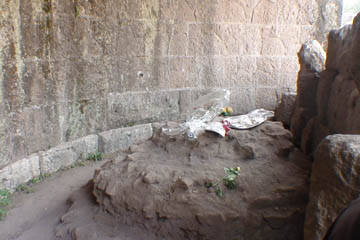
Yet Imperial Rome, with its temples to Jove and all the gods, yielded to the preaching of a few poor men like the apostle Paul, whose tomb we visited in the church of St Paul's-without-the-Walls, and the "testimony" (martyrdom) of those who believed that preaching. The cross that stands in the Colosseum is mute witness to the hundreds, if not thousands, of Christians who were tortured horribly to death or fed to wild animals. We also visited one of the many catacombs in which they buried their dead and in which some of them may have hidden in the times of persecution.
Finally we travelled north to view the last flowering of Roman genius when the barbarian Gothic king Theodorus made Ravenna his capital and adorned its buildings with glorious mosaics that are the wonder of the world. After him came the doomed attempt by Justinian of Byzantium to resurrect the empire and the church of San Vitale is decorated with more beautiful mosaics depicting Justinian and his notorious wife Theodora.
Our last visit, in terms of chronology, was to one of the many states that attempted to recreate or continue the Roman tradition. Venice, with its council and its senators, was a deliberate copy of the institutions of the Roman Republic. Carelessly placed beside the doorway leading out of the Doge's Palace was a stone relief depicting the Tetrarchy - Diocletian, Maximian, Galerius and Constantius - not only cruel persecutors of the church but also the last attempt at rationalising the government of the empire before it fell apart.
I received numerous compliments as the trip drew to its close, but the one I liked best was one not intended for my ears. I happened to overhear someone who had been on one of our tours before comforting an exhausted fellow traveller by saying, "That's the thing about these Down tours; you get to see everything!" Well, we didn't see everything - not by a long way - but we had a great time trying.
© Kendall K. Down 2008
Prison of Socrates This was a bit of a triumph for me, because on a previous visit to Athens I had stumbled across this rock-cut suite of rooms and recognised it from old photographs as the Prison of Socrates. However to be on the safe side I enquired of the guide who we are forced to employ by the government and she looked blank and finally muttered something about it being down in the Agora. I wasn't certain enough to contradict her - but this time I found that the Greeks had erected signboards outside the site, identifying it as the Prison of Socrates.
Diggings staff : 1 - Greek guide : 0 Return





